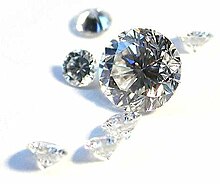Single crystal

A single crystal or monocrystal is a macroscopic crystal whose components ( atoms , ions or molecules ) form a continuous, uniform, homogeneous crystal lattice . This distinguishes single crystals from polycrystalline aggregates, twinned crystals or amorphous substances ( glasses ).
Chemical classification
Analogous to the classification of all chemical substances , single crystals can be divided into two fundamental groups according to their chemical structure:
- Chemical elements : Single crystals of the semiconductor elements silicon and (nowadays rarer) germanium are used in large numbers for electronic devices - mostly in the form of wafers . Large single crystals are produced by inoculating molten starting material with a small single crystal ( seed crystal ) in the Czochralski process (crucible pulling). Another possibility is the zone melting process.
- The carbon modification diamond is often used as a single crystal, not only in the form of diamonds as jewelry, but also when used as a cutting tool, for example in some glass cutters .
- Chemical compounds : Various single crystals made of more or less complex compounds are used technically, for example gallium arsenide in electronics or high-frequency technology, lithium niobate in non-linear optics or sapphire as a highly stable window.
Application for analysis
The crystal structure analysis to elucidate crystal or molecular structures is now a standard method in chemistry and biochemistry. However, crystallization is a prerequisite for this, which can be very difficult, especially with biological molecules. Ideally, the investigation is carried out on a single crystal. Sometimes this is impossible because there are not enough single crystals of a substance available. Nowadays it is possible to evaluate the diffraction pattern of crystal powders within the framework of a crystal structure analysis, but information is lost here due to the superimposition of diffraction maxima, so that the results are of lower quality. But even single crystals that have been grown in a complex manner still have lattice defects .
To determine the structure of chemical compounds using X-rays (which can also be generated by means of a synchrotron ) or neutron beams , single crystals are required in order to determine, among other things, the exact bond lengths and the arrangement of the atoms in a molecule. The crystals used for this are mostly smaller than a millimeter. For macromolecules , macrocyclic compounds and natural products , including proteins , DNA and RNA , single crystal structure analysis can be used to determine the three-dimensional structures down to atomic resolution, if single crystals can be obtained.
Mechanical-technical application
Single crystals are used in technology because of their reproducible properties. Since they have almost no grain boundaries or other structural defects, the mechanical strength of the material increases, for example. So z. B. turbine blades made of a single crystal nickel-based superalloy . These single crystals have a uniform alignment of the lattice structure, but can definitely have several phases .
Single crystalline surfaces and two-dimensional crystals
The surfaces of inorganic single crystals are also single crystalline. They can be understood as two-dimensional single crystals if one only looks at the top layer and are the subject of research in the field of surface chemistry and physics. Single crystal surfaces with a low index are e.g. B. Si (111), Ag (100) or Au (110). On these surfaces, the atoms are arranged on flat terraces, which are interrupted by mostly monoatomic steps. Adsorbates show a different behavior at these stages than on atomically smooth areas. If a single layer of organic molecules is applied to monocrystalline surfaces, self-organizing monolayers are usually obtained with low coverage . These organic layers, which are only one molecular layer high, can be referred to as two-dimensional single crystals, analogous to inorganic single-crystalline surfaces. As with single crystals made up of atoms, the molecules are also highly ordered here. Graphene , a free-standing layer of carbon atoms , lacks long-range crystalline order as expected without a flat base and forms a wavy defect structure.
literature
- Burkhard Altekrüger, Martin Gier: Growing silicon single crystals with a diameter of 300 mm. In: Vacuum in research and practice. 11, No. 1, ISSN 0947-076X , 1999, pp. 31-36, doi : 10.1002 / vipr.19990110110 .
Individual evidence
- ↑ Jacqueline Wahl, Ken Harris: New single crystal superalloys - overview and update . In: MATEC Web of Conferences . tape 14 , 2014, ISSN 2261-236X , p. 17002 , doi : 10.1051 / matecconf / 20141417002 ( matec-conferences.org [accessed July 26, 2020]).
- ↑ Thomas Waldmann, Christina Nenon, Katrin Tonigold, Harry E. Hoster, Axel Groß, R. Jürgen Behm: The role of surface defects in large organic molecule adsorption: substrate configuration effects. In: Physical Chemistry Chemical Physics. 14, No. 30, 2012, p. 10726, doi : 10.1039 / c2cp40800g .
